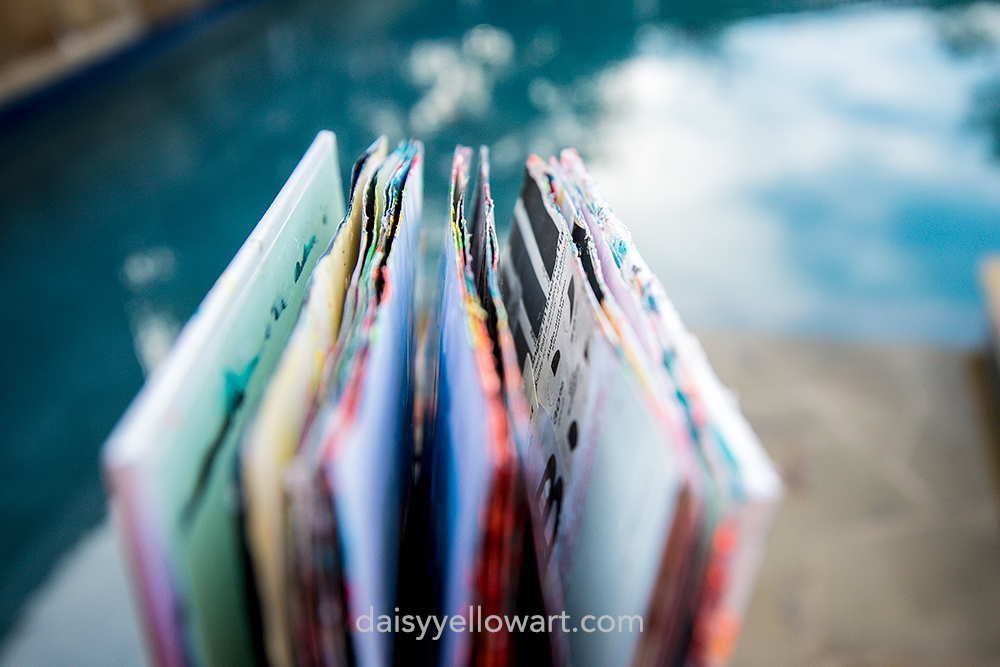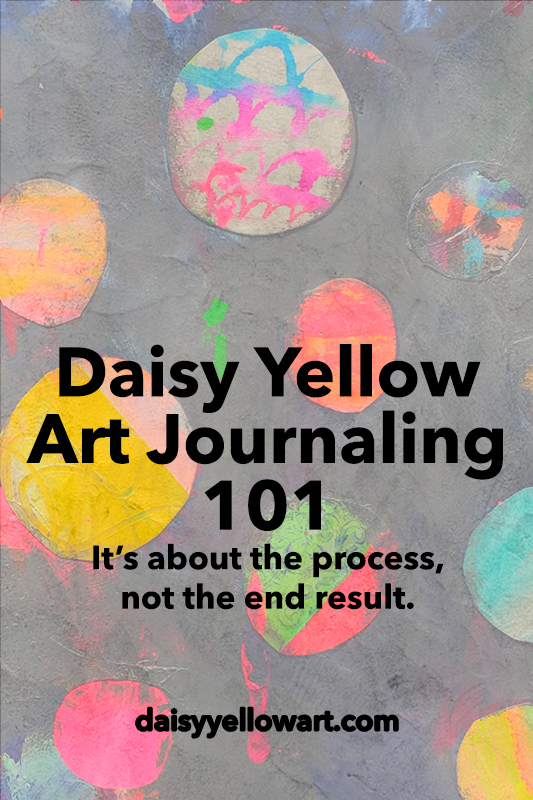My intention is to give you a frame of reference for the art form known as art journaling. I thought it would be helpful to gather these ideas in one place and point you to resources, techniques, and journaling materials to fuel your escapades.

A quick guide to help you start an art journal, including resources for choosing materials, themes, creating backgrounds, and adding words. Art journaling gives you a tool and space to develop a creative practice, work through creative blocks, and express yourself through a combination of words & art! You can experiment with art materials and techniques, styles, and mediums. You’ll find pages from my own personal art journals and additional resources for those who want to delve further into this art form.
Each art journalist will define/perceive/approach “art journaling” differently. When I started art journaling I was just getting into art and was intrigued by the pages I was seeing.
So I went about trying to figure out what it was (and wasn’t) and that is the foundation of Art Journaling 101. My knowledge of art journaling is based on my experience, seeing what other artists were creating, and watching the art form evolve and change.
❝Art journaling is an open-ended form of art on loose paper or in a bound journal where the focus is on the process of creating and of self-expression rather than a particular end result.❞
Drawing, mark-making, writing, painting, and collage are often components. Works often include words, imagery and color, or a combination thereof.

An art journal is an invitation to discover (rediscover, reboot, rekindle) the joy of creating just for the sake of creating. A dedicated space for playful explorations and experiments will fuel your creativity. You can start a journal for any purpose or project and work in a bunch at once.
Working in an art journal is a form of creative self-expression that I find energizing because there are no defined rules — like I could start with an AAA map and combine it with a swatch of acrylic paint and hand-lettered Jimmy Buffett lyrics — or make a gelatin print and cut it up into block letters and glue it to a painted background — I love the ability to combine all sorts of materials and techniques! It’s creatively freeing.
Mixed media art journaling (mixed media just means using more than one medium) typically includes words, imagery & color.
Materials often used in art journaling include paint, pens, paper ephemera, mark-making, printed text, written words, found papers, painted papers, and images on paper.
Art journaling often combines techniques such as drawing, painting, writing, doodling, collaging, and sketching.
Pages are about playing & exploring. You do not need to have a particular structure or composition or have a focal point or theme or be considered pretty. But they can — if you wish.
A journal can be a testing ground for artistic techniques, a place to gather quotations, a calming space, a companion, a playground for self-expression, and a way to document & remember details of daily life.
Art journalists love to incorporate ephemera. This is defined as “items of collectible memorabilia, typically written or printed ones, that were originally expected to have only short-term usefulness or popularity.” So think of things like maps, postcards, clothing tags, and subway tickets. You can tape in photographs or ticket stubs or add stitching or do a tip-in with index card art or staple in diagrams of your dreams.
You can “art journal” (think of this as a verb) without a journal! I’ve been art journaling since 2007 and from my own experience and conversations with other art journalists, the phrase “art journaling” can be confusing. The word “journaling” is the key, and it relates to acts of documentation and self-expression rather than the physical boundaries of the container. So it is not about the surface but the act/experience of creating pages.
You can art journal using loose paper, a bound journal, composition notebook, altered book, sketchbook, cardboard, even a leather-bound writing journal decorated with Miss Kitty stickers.


You can create/start a journal for any purpose or project.
The same journal can be considered more than one type. Kind of like the way that novels can be more than one genre. For example, a travel journal is a type of art journal. Try not to get wrapped up in definitions, just know that the categories overlap and you can refer to and define your journal whatever the heck you want to call it!
A journal can span a specific time period (i.e. 365 day project or a monthly writing diary) or continue across many years until it is filled or let go.
You can work consecutively, page by page, or approach the journal as a whole, working on pages without considering the order.
There are MANY different types of journals — artist's books, illustrated journals, drawing notebooks, field journals, urban sketching journals, composition notebooks, sketchbooks, diaries, accordion books, visual journals, bullet journals, habit trackers, junk journals, travel journals, and altered books! ☜ to add to the fun… many of these terms overlap, so there are multiple names that you could use for a specific journal project
You can use your journal to do all sorts of things — test art materials, construct collages, paint color swatches, document your current fav color palette, practice layering techniques, draw faces, sketch the facades of houses, draw from elements found in nature, doodle patterns and repeats, develop ideas for alphabets, do habit tracking or bullet journaling, make daily diary entries, and write about your travels.
See AlsoHow to Start an Art JournalYou get to make the rules for your own journal — it’s entirely open-ended.
A journal is a space to practice and work in a variety of art mediums. You can test your art materials, do experiments, and figure out how particular materials work.
A journal can be an inviting place to play, to loosen up, not worry about the outcome, and not focus on finished/perfect work.
It is a space where you can express yourself, figure things out, weigh pros & cons, make lists & brainstorm. Use a journal to clarify a decision, get through a difficult phase in your life, find solace while you are ill or injured. A journal is a place where you can document what you are thinking & feeling. This may be a valuable resource as you look back in the years ahead.
Based on what you choose to do, the shape and characteristics of your lines, the elements you choose to incorporate, your work will likely develop into a unique style or personality or perhaps tell a story. You may not be able to see the continuing threads that hold your work together until many years later.


✅ See Art Journaling 102 for materials
Paint — acrylic, watercolor, or gouache
Ink - all sorts
Tools/materials to attach papers to the pages — adhesive, glue, tape, thread
Drawing tools — pens, pencils, markers, pastels, and crayons
Tools to apply or alter paint/ink or add texture — brushes, palette knives, plastic cards, rubber brayers, color shaping tools, rubber stamps, hand-carved stamps, and stencils
Journal or loose paper as base for journaling
Paper & other collage elements
Art journalists collect papers from everyday life. You’ll see artists refer to these as found papers, ephemera & journal fodder. In art journaling, we often tape, stitch, clip, adhere, glue, staple, tuck, fold (or otherwise attach) these papers into our journals.
Things to collect for your journal:Ticket stubs, museum maps, pages from old textbooks, receipts, product packaging, clothing labels, photographs, vintage postcards, lottery tickets, polaroid photos, postage stamps, raffle tickets, hand-written lists, old greeting cards, subway maps, airline tickets, event announcements, advertisem*nts, maps, ribbon, fabric, tarot cards, and images cut from magazines.
As many as you want. Notice the way that you like to work — do you prefer to focus all of your energy on one journal and one type of art — that’s great! Do you thrive on having a bunch of projects going simultaneously — that’s great! The answer is going to be different for each of us! I don’t give myself a limit regarding the number of journals or sketchbooks in process. Each of my journals takes a different direction & focus. So I have MANY in progress.
I love the freedom of having multiple journals, the excitement of having OPTIONS and juggling work in progress. It keeps ideas spinning!No need to attach any negative connotation to having lots of journals in progress.Keeping just one would be stifling to me, so I always have a lot of different journals in process.
Of course not!!! I don’t even count how many journals I have in process. Some are for specific projects or types of art, some are for drawing in the evenings or on the road, some are altered books where I’m painting and collaging, and I even have a journal just for brainstorming letters of the alphabet.
You get to decide how you want to do art and how you choose to use your journals.
Go with whatever works for you! If a stack of journals feels like “too much” or overwhelming and you want to track progress in one space, go for it! You might have one journal for everything, multiple journals for many things, themed journals, big journals, small journals, handmade journals, nature journals, drawing journals, it's totally up to you.
Define your journals, if you wish, name them, title them, alter them, dye them, destroy them, work in reverse chronological order, decoupage the cover, or leave it out in the sun to test light-fastness!
Of course not! It’s 100% OK to leave a journal unfinished. It’s not a failure! I have lots of unfinished journals. It's not that they are melodramatically gathering dust in my attic, sometimes we just move on to other things. That's a natural part of the creative process.
Maybe you are doing one thing in one journal and get totally enamored with this other thing in another journal.
There are a zillion reasons you might abandon or choose not to finish a journal.
We aren’t creativity robots — sometimes you start a project and it just doesn’t go anywhere. You could opt to change the direction of the journal or morph your project or use different materials. But you also do not have to force yourself to finish it. Sometimes life gets busy or you get sick or you are grieving or you just don’t feel up to doing whatever you were doing in that journal. Maybe you plan to make 99 drawings and get bored. Maybe the paper doesn’t fit with your watercolor painting plans.
Go with the flow. Try not to put too many rules on your work because it can feel stiflng. I’ve had all sorts of unfinished journal situations. I remember changing directions in a journal after like page 5 and the first 5 pages annoyed me because they were different. So I tore them out and started again. You can also switch directions inside a journal.
This Introduction to Art Journaling was getting quite long, so I divided into two parts. Art Journaling 102 focuses on art journaling materials, ephemera, and supplies.
More posts & resources to explore:
Choosing Pens for Drawing, Doodling & Sketching
22 Practices to Cultivate & Nurture Creativity
How to trick your inner perfectionist and become an art journalist

